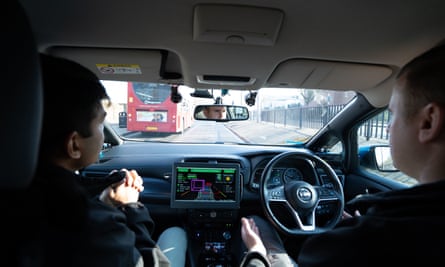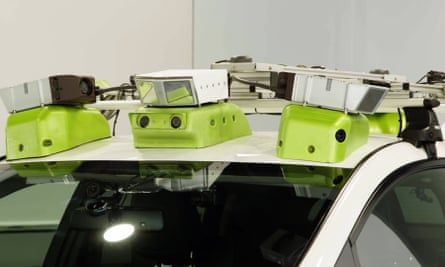[ad_1]
The journey in a self-driving Nissan across Woolwich in south-east London begins smoothly enough: fitted with cameras and sensors, the electric car confidently handles pedestrian crossings, vans cutting into its lane without warning and even scurrying jaywalkers.
Then comes an unexpected obstacle: a football-sized rock, fallen from the back of a lorry on to the middle of the road. The specially trained safety driver hastily grabs the steering wheel, taking back control to avoid a nasty crunch.
It is hardly a major incident – and it is the only human intervention during five miles of navigating busy traffic in a demonstration of the ServCity research programme being carried out by the carmaker and partners in London. Nevertheless, it highlights the difficulties facing autonomous driving technology before it can become mainstream – particularly on Britain’s busy and often chaotic urban roads.
“It’s a long-term journey we’re on,” says Matthew Ewing, Nissan’s vice-president for vehicle engineering in Europe.

Hands-free driving is still banned in the UK, although the government last summer pledged to allow the first self-driving cars on British roads by 2025. Carmakers are racing to develop the technology to be able to launch driverless taxis and eventually personal vehicles that can travel anywhere without human input.
Every large automotive company is looking ahead to autonomous cars, while startups such as the Alphabet-owned Waymo and the General Motors-owned Cruise have also invested heavily. Cruise has driven paying customers in driverless “robotaxis” in San Francisco, Phoenix and Austin in the US. In London, autonomous car trials have been carried out by the startups Oxbotica, Wayve and the Academy of Robotics.
The ServCity project, which has received £7m from the UK government and is drawing to an end next month, is looking at ways to improve performance in cities in particular. The project has driven 1,600 miles on a 2.7-mile route around Woolwich with 270 cameras plus other sensors. They allow the team to collect data, but also to experiment with features such as giving the car advanced warning of obstacles including parked buses blocking the lane ahead – even when well beyond the line of sight.

A Nissan car has already demonstrated what is possible in the UK. Two years ago a Leaf drove 230 miles using autonomous technology from the company’s technical centre in Cranfield, Bedfordshire, to its manufacturing plant in Sunderland, where the model is made. Most of that journey on predictable motorways was handled by computer, but safety drivers still had to intervene a few times. Taking the next step to full autonomy is proving tricky.
“We probably have 80% of the capability, but that last 20% is going to take some time,” Ewing says.
Nissan and its rivals have for 20 years been gradually adding autonomous capabilities such as maintaining a safe distance from the car in front on motorways and lane-keeping. However, the transition from those level 1 or 2 driver assistance systems to level 3 – when the car is fully in control for at least some of the time – can be very difficult.
after newsletter promotion
London is also a particularly testing environment – at least when compared with the broad boulevards of the US or the orderly traffic of Yokohoma, Japan, where Nissan is headquartered.

Self-driving capabilities are split by the standards body SAE into six levels: 0 for no autonomy, and level 5 for full automation (where you could fall asleep and wake up at your destination). The cutting edge at the moment is nudging level 3: cars that are capable of driving themselves, but which could ask the driver to intervene at any point.
Even Tesla, whose chief executive, Elon Musk, has promised robotaxis for years, still says that its “full self-driving” software is only able to provide “active guidance and assisted driving under your active supervision”. The carmaker has faced criticism for its claims of “full self-driving” – including in an advert from a wealthy critic at this year’s Super Bowl – and an investigation by the US justice department.
Ewing says the UK is still in a “good position” relative to other countries – although it needs to keep up with the EU as the technology becomes closer to mainstream adoption, and more of the features are used in cars for sale.
“My feeling is it will be a gradual, step-by-step process,” he says. “It’ll become more and more normal feeling.”
[ad_2]
#longterm #journey #ride #selfdriving #cars
( With inputs from : www.theguardian.com )


